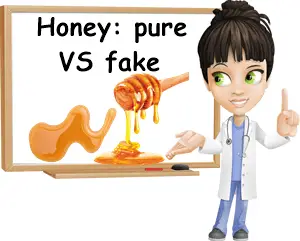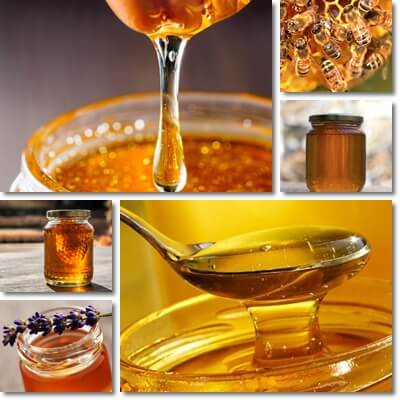Honey is one of the most commonly counterfeit food products. It has become so common to fake honey, that consumers are becoming accustomed to processed honey-like products and looking funny at the real thing. Real, raw honey can be easy to tell apart from fake honey, just by how it looks, how it tastes, how it flows and general appearance and behavior, clear markers of purity. But you would have to have had some experience with the real thing to be able to know the difference.
For the most part, you shouldn’t need to run sophisticated laboratory tests to tell the difference between pure honey and a fake, adulterated honey-like product.
Find out below what you should look for in your honey.
Stickiness
Real honey is not sticky as you’d expect. In fact, if you touch honey or rub some between your fingers, it’ll feel soft, almost velvety, but not sticky like a cheap sugary syrup, for example. If it’s been adulterated, it will feel sticky to the touch, similar to a cheap, sugary syrup.

Viscosity or thickness
Real honey is over 80% sugar, sometimes more (some varieties have only 13% water), and, as a result, has a distinct thickness to it. It’s called viscosity and it’s the characteristic that makes honey resist flow. Although technically a liquid, when you let it drip from a dipper, real honey will have a certain resistance to flow and will look thick and stretchy as it pours in a heavy, dense, almost lush flow.
Honey that has been processed, adulterated with corn syrup or other sweeteners, will flow more like a liquid, continually and swiftly, in a thinner stream. If you tilt an emptier jar of honey, it should resist flow and move along the sides with slow, thick motions.
Fake honey has a lighter, quicker flow. Some honeys might not drip at all, especially varieties that are known to crystallize fast (example: rapeseed honey, sunflower honey, aster honey).
Taste persistence
Despite being over 80% fructose and glucose sugars and sweet-tasting, the taste of real honey does not linger very long in the mouth. Only for as long as it takes to dissolve the honey with saliva and swallow it – and it will take a little while given its natural viscosity. Fake honey that has been adulterated will leave the mouth tasting sweet for longer, like a cheap sugary syrup.
Particular flavors or scents
Honey bees pass onto honey unique volatile organic compounds from the nectar of the plants they visit. Certain monofloral honeys will have particular flavors or scents, overall unique aroma profiles, sometimes reminiscent of the nectar of the flower species they are made from. For example, sunflower honey has a certain oily characteristic, perceivable both at the olfactory and gustatory level. Eucalyptus honey also has some faint mentholated, warm earthy flavors. Rapeseed honey may have light peppery flavors, reminiscent of cabbage or mustard pungency. Fake honey won’t have any particular flavors.

Glass of water test
One of the simplest tests you can do to tell the difference between real and fake honey is the glass of water test. Slowly pour a spoonful of honey in a glass of water: if it settles at the bottom, it’s real; if it dissolves, it’s fake. Of course, if you stir the water, both real and fake honey will eventually dissolve. The reason why this test helps you identify pure, original, unadulterated raw honey is because it relies on a characteristic unique to honey: viscosity.
Bread test
Another simple test you can do at home to tell if your honey is real is to spread honey on a slice of bread and wait a few minutes. Real honey has a low water content – on average, about 18%, but some varieties have a water content as low as 13%. Because of this, real honey should not make the bread moist. Instead, you should see the bread harden or dry out slightly. Fake honey is usually higher in water and will moisten the bread.
Paper towel test
Gently pour a few drops of honey on a delicate paper towel. If it’s real, the honey should settle atop of the paper. Its high viscosity, aka thickness, due to the high sugar and low water content, prevents it from wetting the paper towel. If it’s fake, it will either get absorbed in the paper towel or leave signs of a moisture content higher than normal. The test also works with blotting paper.
Appearance
A great way to tell if honey is real is to look for impurities. Original honey in its raw form is packed by honeybees in honeycombs. The combs are made of wax, so after extraction, real raw honey will have impurities such as wax particles from the comb, pollen grain, propolis etc. These will be visible in the honey. Even if it has been strained to remove bigger impurities, it will still not look perfectly clear. Honey that looks clear throughout has likely been filtered which most often implies heating – heating adulterates the product, reducing its natural properties.
Liquid vs crystallized honey
If you want to make sure you get real honey, you can always get a jar that has started to crystallize or is even already crystallized. Check the variety and do some research: some honeys will crystallizes in a matter of weeks or a couple of months tops after extraction, such as sunflower and rapeseed honey, while others may take years, if properly stored (for example, tupelo honey). Fake, adulterated honey is especially processed to resist crystallization, hence its more liquid than normal state.
Conclusion
If you were looking for ways to test honey to see if it’s real or fake, if it has been adulterated and in what way, the methods listed above are the simplest tests you can run at home. If your honey passes most of these, it should be real and unadulterated. If it’s been adulterated in the sense that it’s been heated and filtered, or watered down with cheap sugary solutions, it should be unusually thin or liquid (lacking its characteristic viscosity), watery, sticky and too sweet.
Even honey that looks too clear has likely been heated to improve filtration results, which takes away from its properties. Of course, no method is foolproof and no test can 100% guarantee purity. It helps though to know the real thing, so make sure you also do your research about the honey variety you are looking to buy and its characteristics, as well as research the producer and brand.
